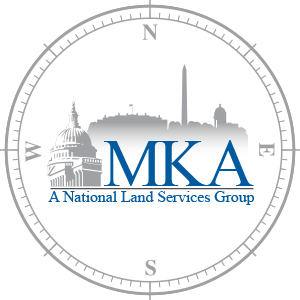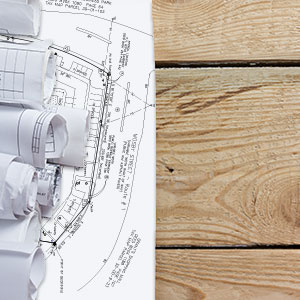
Surveying and Engineering Terms
A - Acre, Aliquot, Arpent, Auditor's Map, Azimuth
- Acre - The (English) acre is a unit of area equal to 43,560 square feet, or 10 square chains, or 160 square poles. It derives from a plowing area that is 4 poles wide and a furlong (40 poles) long. A square mile is 640 acres. The Scottish acre is 1.27 English acres. The Irish acre is 1.6 English acres.
- Aliquot - The description of fractional section ownership used in the U.S. public land states. A parcel is generally identified by its section, township, and range. The aliquot specifies its precise location within the section, for example, the northwest quarter of the southeast quarter.
- Arpent - Unit of length and area used in France, Louisiana, and Canada. As a unit of length, approximately 191.8 feet (180 old French 'pied', or foot). The (square) arpent is a unit of area, approximately .845 acres, or 36,802 square feet.
- Auditor's map - was made by the County Surveyor at the request of the auditor for tax purposes. Many were made in the 1800's. Very little field work was done. The map was created bu the use of various documents, piecing together other surveys, a few rough measurements in the field, etc. Generally, not accurate.
- Azimuth - The number of degrees from north (or other reference direction) that a line runs, measured clockwise.
B - Back sign, Baseline, Bearing, Benchmark, Boundary Survey
- Back sight - After measuring from point A to B, reading the heading from B back to A. Various factors can cause the headings to not be exactly the reverse of one another.
- Baseline - In the U.S. Public land surveying system, a surveyed east-west (i.e. latitudinal) reference line, often hundreds of miles in length, from which tiers of townships are are surveyed to the north and south. There are approximately two dozen baselines in the lower 48 states. See also meridian.
- Bearing - See azimuth. Bearings taken with a compass will be referenced to magnetic north unless otherwise noted.
- Benchmark - A survey mark made on a monument having a known location and elevation, serving as a reference point for surveying.
- Boundary Survey - A survey made to establish or re-establish a boundary line on the ground or to obtain data for constructing a map or plat showing a boundary line.
C - Call, Chain, Chain Carrier, Chain of Title, Chord, Colpa, Compass, Condition, Conditional Line, Corner, Cuerda
- Call - Any feature, landmark, or measurement called out in a survey. For example, "two white oaks next to the creek" is a call. So is "North 3 degrees East 120 poles".
- Chain - Unit of length usually understood to be Gunter's chain, but possibly variant by locale. See also Rathbone's chain. The name comes from the heavy metal chain of 100 links that was used by surveyors to measure property bounds.
- Chain carrier - An assistant to the surveyor, the chain carriers moved the surveying chain from one location to another under the direction of the surveyor. This was a position of some responsibility, and the chain carriers took an oath as "sworn chain carriers" that they would do their job properly.
- Chain of Title - A term applied to the series of deeds or conveyances affecting a parcel of land.
- Chord - The straight line connecting the end points of an arc.
- Colpa - Old Irish measure of land equal to that which can support a horse or cow for a year. Approximately an Irish acre of good land.
- Compass - One toise.
- Condition - See Conditional line.
- Conditional line - An agreed line between neighbors that has not been surveyed, or which has been surveyed but not yet granted.
- Corner - The beginning or end point of any survey line. The term corner does not imply the property was in any way square.
- Cuerda - Traditional unit of area in Puerto Rico. Equal to about .971 acres. Known as the "Spanish acre".
D - Declination, Deed
- Declination - The difference between magnetic north and geographic (true) north. Surveyors used a compass to determine the direction of survey lines. Compasses point to magnetic north, rather than true north. This declination error is measured in degrees, and can range from a few degrees to ten degrees or more. Surveyors may have been instructed to correct their surveys by a particular declination value. The value of declination at any point on the earth is constantly changing because the location of magnetic north is drifting. More information about historical values of declination is available.
- Deed - A sealed written document or instrument containing some transfer, bargain, or contract especially pertaining to real estate.
E - Engineer's Chain
- Engineer's Chain - A 100 foot chain containing 100 links of one foo
F - First station, Flag, Furlong
- First station - See Point of Beginning.
- Flag - A bright plastic ribbon tied to a lath stake. Used to mark points along a survey line.
- Furlong - Unit of length equal to 40 poles (220 yards). Its name derives from "furrow long", the length of a furrow that oxen can plow before they are rested and turned. See Gunter's chain.
G - Gore, Ground, Gunter's Chain
- Gore - A thin triangular piece of land, the boundaries of which are defined by surveys of adjacent properties. Loosely, an overlap or gap between properties. See also strip.
- Ground - A unit of area equal to 2400 sq. ft., or 220 sq. meters, used in India.
- Gunter's Chain - Unit of length equal to 66 feet, or 4 poles. Developed by English polymath Edmund Gunter early in the 1600's, the standard measuring chain revolutionized surveying. Gunter's chain was 22 yards long, one tenth of a furlong, a common unit of length in the old days. An area one chain wide by ten chains long was exactly an acre. In 1595 Queen Elizabeth I had the mile redefined from the old Roman value of 5000 feet to 5280 feet in order for it to be an even number of furlongs. A mile is 80 chains.
H - Hectare, Hide, Hundred
- Hectare - Metric unit of area equal to 10,000 square meters, or 2.471 acres, or 107,639 square feet.
- Hide - A very old English unit of area, a hide was of variable size depending on locale and the quality of the land. It was the amount of land to support a family, and ranged from 60 to 180 acres. After the Norman conquest in 1066 it became standardized at around 120 acres.
- Hundred - An adminstrative area larger than a village and smaller than a county. In England it was 100 hides in size, and the term was used for early settlements in Virginia, Maryland, and Delaware.
L - Labor, Landmark, League, Line Tree
- Labor - The labor is a unit of area used in Mexico and Texas. In Texas it equals 177.14 acres (or 1 million square varas).
- Landmark - A survey mark made on a 'permanent' feature of the land such as a tree, pile of stones, etc.
- League (legua) - Unit of area used in the southwest U.S., equal to 25 labors, or 4428 acres (Texas), or 4439 acres (California). Also, a unit of length--approximately three miles.
- Line Tree - Any tree that is on a property line, specifically one that is also a corner to another property. Link - Unit of length equal to 1/100 chain (7.92 inches).
M - Merestone, Meridian, Mete, Metes and Bounds, Monument, Morgen
- Merestone - A stone that marks a boundary. See monument.
- Meridian - In the U.S. public land surveying system, a surveyed north-south (i.e. longitudinal) reference line, often hundreds of miles in length, from which ranges are surveyed to the east and west. There are approximately two dozen meridians in the lower 48 states. See also baseline.
- Mete - In the context of surveying, a measure, i.e. the direction and distance of a property line.
- Metes and Bounds - An ancient surveying system that describes the perimeter of a parcel of land in terms of its bearings and distances and its relationship to natural features and adjacent parcels.
- Monument - A permanently placed survey marker such as a stone shaft sunk into the ground.
- Morgen - Unit of area equal to about .6309 acres. It was used in Germany, Holland and South Africa, and was derived from the German word Morgen ("morning"). It represented the amount of land that could be plowed in a morning.
O - Open line, Out
- Open line - A survey line, usually the final one, that is not measured and marked (blazed) by the surveyor but is instead calculated.
- Out - An 'out' was ten chains. When counting out long lines, the chain carriers would put a stake at the end of a chain, move the chain and put a stake at the end, and so on until they ran "out" of ten stakes.
P - Perch, Plot plan, Plunge, Point, Point of Beginning, Point of intersection, Pole, Protraction, Pueblo
- Perch - See pole . Plat - A drawing of a parcel of land. More specifically, the drawing created by the surveyor that shows the field work, with bearings, distances, etc.
- Plot plan - A diagram showing the proposed or existing use of a specific parcel of land.
- Plunge - 1) Inversion of a transit in order to make measurements that cancel errors in the transit, or to extend a line over an obstacle. 2) The angle a falling line makes with the horizontal.
- Point - A point of the compass. There are four cardinal points (North, South, East, West), and 28 others yielding 32 points of 11.25 degrees each. A survey line's direction could be described as a compass point, as in "NNE" (northnortheast). To improve precision, the points would be further subdivided into halves or quarters as necessary, for example, "NE by North, one quarter point North". In some areas, "and by" meant one half point, as in "NE and by North".
- Point of Beginning - The starting point of the survey.
- Point of intersection - The point where two non-parallel lines intersect. More specifically, the point where two tangents to a curved line intersect.
- Pole - Unit of length and area. Also known as a perch or rod. As a unit of length, equal to 16.5 feet. A mile is 320 poles. As a unit of area, equal to a square with sides one pole long. An acre is 160 square poles. It was common to see an area referred to as "87 acres, 112 poles", meaning 87 and 112/160 acres.
- Protraction - in the rectangular survey system, the representation of a boundary or corner not run, marked, or fixed by the field survey as evidenced by the field notes. For example, a surveyed section might be protracted into lots by someone in the office.
- Pueblo - A Spanish grant of less than 1000 acres.
R - Relief
- Relief - The variation in the elevation of the ground surface.
S - Station
- Station - A point on a traverse over which a surveying instrument is placed or a point of the earth's surface whose location has been determined by survey methods.
T - Title Report, Topography, Topographic Survey, Traverse
- Title Report - A statement of the current condition of title for a parcel of land.
- Topography - The features of the actual surface of the earth considered collectively as a form.
- Topographic Survey - A map which reflects the horizontal and vertical positions of the surface features of the area presented.
- Traverse - A series of lengths and directions (angles) obtained by or from field measurements, and used to determine positions of the points.
V - Vara, Virgate
- Vara - Unit of length (the "Spanish yard") used in the U.S. southwest. The vara is used throughout the Spanish speaking world and has values around 33 inches, depending on locale. The legal value in Texas was set to 33 1/3 inches early in the 1900's.
- Virgate - An old English unit of area, equal to one quarter of a hide. The amount of land needed to support a person.
Z - Zenith angle
- Zenith angle - An angle measured from a vertical reference. Zero degrees is a vertical line pointing up, 90 degrees is horizontal, and 180 degrees is straight down.





